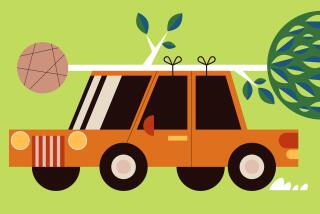Mini-Farm Cropping Up in Irvine Easement
- Share via
Rows of tiny green sprigs are bursting through Irvine’s soil in an otherwise nondescript patch of dirt within eyeshot of the Eastern tollway.
City officials hope the seedlings will soon grow into a field of multicolored vegetables, which can be used to stock county food banks, teach schoolchildren about the importance of agriculture and dress up an old utilities easement that was destined to be overrun with weeds.
The acres of young crops are the template for Irvine’s edible-landscaping project, which uses barren easements and rights-of-way to produce public gardens.
“You have areas like this that have been fallow for years,” said Steve Bourke, Irvine public works superintendent. “It’s someplace between ‘not an eyesore’ and ‘unattractive.’ We wondered, ‘Can we green up this area? Can we improve its appearance without putting in turf trees and make it more appealing in an untraditional way?’ ”
Local grower A.G. Kawamura answered with a resounding yes and decided to bring the program to life. He is so excited at the prospect of a public garden that he is providing the city with supplies and labor at no cost.
By donating the land, which Irvine leases from Southern California Edison for a portion of its regional bike path, the city beautifies some of its open space and saves money by eliminating the need for weed abatement, city officials said.
“Agriculture isn’t just an interim plan while we pave everything over, but a long-term, integral part of our community’s life,” said City Councilman Larry Agran. “It’s an economical and productive use of otherwise unattractive land.”
Kawamura said the budding fields of produce will provide a lush, refreshing alternative to the typical landscaping on city easements.
“Similar to a display of flowers, we’re growing things not day to day but season to season, so the bulk of the time that product is a growing part of the scenery,” Kawamura said.
Officials hope to bring students through the easement to give them a firsthand look at what goes into raising commercial crops.
“One of the things [Kawamura’s] trying to do is educate schoolkids that, quite frankly, celery doesn’t come from Albertsons,” Bourke said. “What he wants to do is have something like this to show that food and agriculture is an integral part of this society.”
Kawamura believes in early education to prevent poor nutritional habits.
“Hunger, obesity and anorexia are all symptoms of malnutrition,” he said. “Alternative and agricultural education coming from projects like this can go a long way toward helping your kids get an adequate diet.”
The four acres of celery and jalapenos planted last week are the city’s testing ground. Kawamura said other low-maintenance vegetables, such as potatoes and carrots, will be added later.
The grower estimates that the easement will produce eight to 12 tons of produce this year. Most of the food will be distributed to local food banks, soup kitchens and other service organizations through Second Harvest, a Santa Ana-based nonprofit group, Bourke said.
The city will remain in contact with residents near the land and evaluate the program at the end of the year before deciding whether to continue it or plant similar crops in other easements.
“We want to make sure the bike trail use is maintained and that [the project is] done in a way that’s not a burden to the neighbors and kept clean,” he said. “In relation to a commercial farm, this should be a whole lot neater because it does serve as a landscape.”
More to Read
Sign up for Essential California
The most important California stories and recommendations in your inbox every morning.
You may occasionally receive promotional content from the Los Angeles Times.













